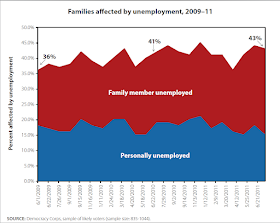It is well known that the headline unemployment rate is deceptive and does not represent the true state of the labour market. Some of the figures, highlighted in an excellent recent EPI briefing paper (pdf here), are truly staggering, reminiscent of the economic situation in an impoverished developing country,
"Roughly 31% of U.S. workers experienced unemployment or underemployment at some point in 2009... Though roughly 31% of all U.S. workers experienced unemployment or underemployment at some point in 2009—the rates were higher for African-American and Hispanic workers, at 36% and 41%, respectively. Whereas 14.3% of white children had an unemployed or underemployed parent in 2010, one in four African-American or Hispanic children had an underemployed parent."
For the record, the unemployment rate today stands at 9.1%. But, as the aforementioned figures indicate, the underlying story is very dismal.

In 2010, the unemployment rate averaged 9.6%, but 10.6% of children had at least one unemployed parent.

And the weakness in labour market has not spared anybody, calling to question the conservative theme that the labour market is beset with structural problems. The severity of job scarcity - ratio of job seekers (unemployed) to job openings has been substantially above 4-to-1 for more than two-and-a-half years - and the duration of job search - share of unemployed workers who have been out of work for over six months has hovered around 45% for more than a year - means that the problem is simply one of a severe jobs shortfall. The unemployment has more than doubled for workers in every education group, including those with a college degree or an advanced degree.

The jobs shortfall in the labor market is roughly 11.1 million jobs—there are 6.8 million fewer jobs than there were when the recession started, and 4.3 million additional jobs were needed to keep pace with the growth in the working-age population.

To fill the gap by mid-2014, three years from now, 400,000 jobs would need to be created each month. However, over the last six months, the economy has added an average of 144,000 jobs each month — at that rate, it will take 15 years to get back to the pre-recession unemployment rate. The other estimates too are not encouraging. Even the most oprimistic forecasters expect the unemployment rate to be at least 8.5% at the end of 2012, a rate higher than the worst months of the prior two recessions.

There is another trend with the US labour market that deserves much greater attention. It concerns the widening differential between the productivity growth and wage compensation growth.

The clearest evidence of where this could be going is the widening wage gap between the workers and the executives, and in the current recession, the sharp increase in corporate profits.

Thanks to all this, the US labour market has now slipped below even the much derided European labour market, portions of which have not only managed to stave off the worst of the Great Recession, but even improve.

In the meantime, the August jobs report is yet another confirmation of the gravity of problems facing the US economy. The unemployment rate remained stagnant at 9.1% as the economy failed to add any new jobs, the first time in the past 11 months. The broader measure of unemployment, including those who have looked for work in the past year but have now stopped looking for work and those who are involuntarily working part time instead of full time, fell from 16.3 to 16.1%.
The number of long-term unemployed — people out of work for 27 weeks or more — remained about the same as in July, at 6 million, as did the median duration of unemployment, at 19.6 weeks compared to 19.7 weeks in July. The percent of working-age adults that were employed, already at its lowest rate since 1983, ticked down from 58.6 percent to 58.5 percent. The graphic below clearly conveys the magnitude of the present jobs crisis when compared to the earlier recessions.

No comments:
Post a Comment